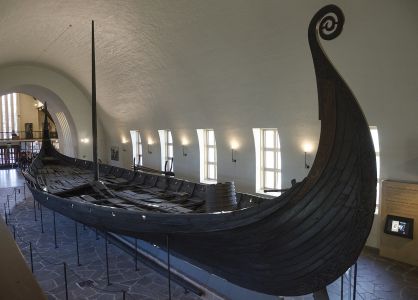 Here is a post suitable for Halloween. It is not a ghost story but rather the tale of two mysterious skeletons found in a Viking ship discovered in a large burial mound at the Oseberg farm near Tønsberg in Vestfold og Telemark county, Norway. The ship itself, dating back to the early 800s AD, is among the best-preserved vessels to have survived from the Viking era. As beautiful and fascinating as the ship is, what is truly intriguing are the remains of the two individuals laid to rest inside the ship.
Here is a post suitable for Halloween. It is not a ghost story but rather the tale of two mysterious skeletons found in a Viking ship discovered in a large burial mound at the Oseberg farm near Tønsberg in Vestfold og Telemark county, Norway. The ship itself, dating back to the early 800s AD, is among the best-preserved vessels to have survived from the Viking era. As beautiful and fascinating as the ship is, what is truly intriguing are the remains of the two individuals laid to rest inside the ship.
Ship burials were reserved for the most powerful and wealthiest of the elites of their time. But rather than finding that the Oseberg ship was the burial place of a king or mighty warlord, DNA studies revealed that the partial skeletons in the ship were the remains of two women. The elder is believed to have been roughly 80 when she died, while the younger woman must have been around 40. The women were found together in one bed.
Centuries before the excavation in 1904, the mound had been robbed of precious metals, but the grave goods that remained suggested a high-status burial. These included textiles, a richly carved four-wheel wooden cart, bed-posts, and wooden chests, as well as a bucket made from yew wood, held together with brass strips with a brass and cloisonné enamel ornamented handle. There were also the skeletal remains of 14 horses, an ox, and three dogs found on the ship.
Who were the two women buried in the mound? Historians have long thought that the older woman was Queen Åsa of the Yngling clan, mother of Halfdan the Black, and grandmother of Harald Fairhair. Recent research has suggested that the queen outlived the woman in Oseberg, so there is no consensus on who the woman may be.
One more intriguing detail — the older woman also had Morgagni’s syndrome, which would have given her a masculine appearance and beard. Some scholars believe that she may have been a shaman. She was clearly an individual of high status, but was she a queen or a witch? We will likely never know.
The Oseberg ship is currently housed in the Viking Ship Museum in Oslo, Norway. The museum is currently closed and will reopen in 2026/2027 as the Museum of the Viking Age.
